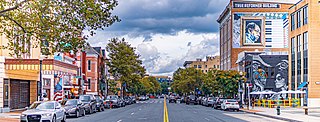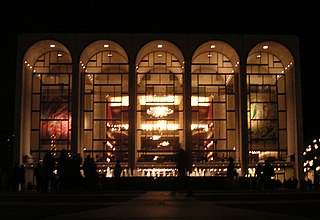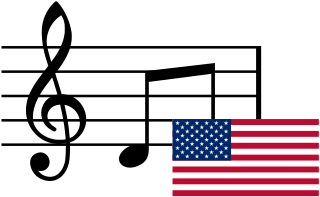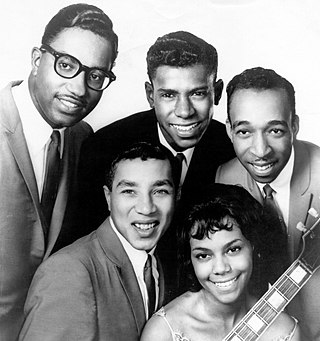
Musical theatre is a form of theatrical performance that combines songs, spoken dialogue, acting and dance. The story and emotional content of a musical – humor, pathos, love, anger – are communicated through words, music, movement and technical aspects of the entertainment as an integrated whole. Although musical theatre overlaps with other theatrical forms like opera and dance, it may be distinguished by the equal importance given to the music as compared with the dialogue, movement and other elements. Since the early 20th century, musical theatre stage works have generally been called, simply, musicals.

George Gard "Buddy" DeSylva was an American songwriter, film producer and record executive. He wrote or co-wrote many popular songs, and along with Johnny Mercer and Glenn Wallichs, he co-founded Capitol Records.
Jazz standards are musical compositions that are an important part of the musical repertoire of jazz musicians, in that they are widely known, performed, and recorded by jazz musicians, and widely known by listeners. There is no definitive list of jazz standards, and the list of songs deemed to be standards changes over time. Songs included in major fake book publications and jazz reference works offer a rough guide to which songs are considered standards.

Washington, D.C., has been home to many prominent musicians and is particularly known for the musical genres of Jazz, Rhythm & Blues, bluegrass, punk rock and its locally-developed descendants hardcore and emo, and a local funk genre called go-go. The first major musical figure from District of Columbia was John Philip Sousa, a military brass band composer. Later figures include jazz musicians, such as Duke Ellington, Charlie Rouse, Buck Hill, Ron Holloway, Davey Yarborough, Michael A. Thomas, Butch Warren, and DeAndrey Howard; soul musicians, including Billy Stewart, The Unifics, The Moments, Ray, Goodman & Brown, Van McCoy, The Presidents, The Choice Four, Vernon Burch, guitarist Charles Pitts, and Sir Joe Quarterman & Free Soul.

The music of New York City is a diverse and important field in the world of music. It has long been a thriving home for popular genres such as jazz, rock, soul music, R&B, funk, and the urban blues, as well as classical and art music. It is the birthplace of hip hop, garage house, boogaloo, doo wop, bebop, punk rock, disco, and new wave. It is also the birthplace of salsa music, born from a fusion of Cuban and Puerto Rican influences that came together in New York's Latino neighborhoods in the 1940s and 1950s. The city's culture, a melting pot of nations from around the world, has produced vital folk music scenes such as Irish-American music and Jewish klezmer. Beginning with the rise of popular sheet music in the early 20th century, New York's Broadway musical theater, and Tin Pan Alley's songcraft, New York has been a major part of the American music industry.

Many musical styles flourished and combined in the 1940s and 1950s, most likely because of the influence the radio had in creating a mass market for music. World War II caused great social upheaval, and the music of this period shows the effects of that upheaval.

Douglas Stuart Moore was an American composer, songwriter, organist, pianist, conductor, educator, actor, and author. A composer who mainly wrote works with an American subject, his music is generally characterized by lyricism in a popular or conservative style which generally eschewed the more experimental progressive trends of musical modernism. Composer Virgil Thomson described Moore as a neoromantic composer who was influenced by American folk music. While several of his works enjoyed popularity during his lifetime, only his folk opera The Ballad of Baby Doe (1956) has remained well known into the 21st century.

Cy Coleman was an American composer, songwriter, and jazz pianist.

A session musician is a musician hired to perform in a recording session or a live performance. The term sideman is also used in the case of live performances, such as accompanying a recording artist on a tour. Session musicians are usually not permanent or official members of a musical ensemble or band.

Susan Werner is an American singer-songwriter. Much of Werner's work has been in the contemporary folk genre.

Children's music or kids' music is music composed and performed for children. In European-influenced contexts this means music, usually songs, written specifically for a juvenile audience. The composers are usually adults. Children's music has historically held both entertainment and educational functions. Children's music is often designed to provide an entertaining means of teaching children about their culture, other cultures, good behavior, facts and skills. Many are folk songs, but there is a whole genre of educational music that has become increasingly popular.

Music history of the United States includes many styles of folk, popular and classical music. Some of the best-known genres of American music are rhythm and blues, jazz, rock and roll, rock, soul, hip hop, pop, and country.

American popular music is popular music produced in the United States and is a part of American pop culture. Distinctive styles of American popular music emerged early in the 19th century, and in the 20th century the American music industry developed a series of new forms of music, using elements of blues and other genres. These popular styles included country, R&B, jazz and rock. The 1960s and 1970s saw a number of important changes in American popular music, including the development of a number of new styles, such as heavy metal, punk, soul, and hip hop.
Yiddish song is a general description of several genres of music sung in Yiddish which includes songs of Yiddish theatre, Klezmer songs, and "Yiddish art song" after the model of the German Lied and French mélodie.

A Trip to Chinatown is a musical comedy in three acts with a book by Charles H. Hoyt, music by Percy Gaunt and lyrics by Hoyt. In addition to the Gaunt and Hoyt score, many songs were interpolated into the score at one time or another during the run, as was fashionable for musicals of the era. The story concerns a widow who accidentally maneuvers two young suburban couples into a big city restaurant and brings romance to them and herself. It is loosely based on an 1835 English one-act farce, A Day Well Spent, by John Oxenford.

This article includes an overview of the events and trends in popular music in the 1960s.
This article includes an overview of the major events and trends in popular music in the 1950s.
Popular music is music with wide appeal that is typically distributed to large audiences through the music industry. These forms and styles can be enjoyed and performed by people with little or no musical training. As a kind of popular art, it stands in contrast to art music. Art music was historically disseminated through the performances of written music, although since the beginning of the recording industry, it is also disseminated through recordings. Traditional music forms such as early blues songs or hymns were passed along orally, or to smaller, local audiences.
A sentimental ballad is an emotional style of music that often deals with romantic and intimate relationships, and to a lesser extent, loneliness, death, war, drug abuse, politics and religion, usually in a poignant but solemn manner. Ballads are generally melodic enough to get the listener's attention.

Development of musical theatre refers to the historical development of theatrical performance combined with music that culminated in the integrated form of modern musical theatre that combines songs, spoken dialogue, acting and dance. Although music has been a part of dramatic presentations since ancient times, modern Western musical theatre developed from several lines of antecedents that evolved over several centuries through the 18th century when the Ballad Opera and pantomime emerged in England and its colonies as the most popular forms of musical entertainment.













